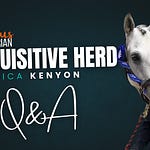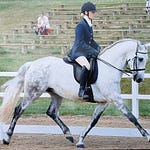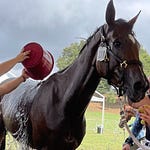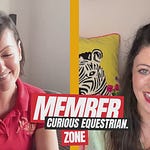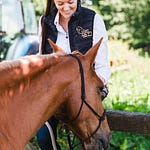In this conversation, we explore the insights of Josefa Guillaume, an international horse trainer, instructor, and author of Dressage in Hand: What Horses Want You to Know. Josefa has dedicated over twenty years to working with horses, including injured and traumatized animals, focusing on teaching dressage movements from the ground rather than the saddle. Anna Louise and Josefa dive into the evolving perception of horses within the equestrian community, the ethical challenges facing dressage competition today, and the potential transformation that could come from viewing horses as pets rather than mere sporting animals.
The Bond Between Humans and Horses: A Historical and Personal Perspective
Josefa, when did you first start thinking of horses as pets, especially given your extensive experience with equines?
I've always thought of horses as pets. It never really occurred to me that they would be anything else. As a little girl, I dreamed of having my own horse, not just to ride but to keep as a companion. Riding was never the most important thing for me; it was the relationship, the bond. So, for me, horses have always been pets, friends, and family members.
Not yet part of our Inquisitive Herd? Above you'll find a 1-minute preview of our conversation with Annabelle Holmes. Join our community today to watch the complete interview ad-free and access our library of exclusive content on sustainable horse care.
Or watch free with ads on our YouTube Channel
How has this perspective influenced your approach to horse training?
Because I see horses as thinking individuals, much like humans, cats, or dogs. I always approach training with empathy. I think about how I would want to be treated and apply that same standard to horses. This mindset makes me different from many trainers who see horses primarily as tools or athletes. For me, every interaction is about mutual respect and understanding.
Why do you think horses haven't traditionally been considered pets in the same way as cats or dogs?
That's a fascinating question. Horses have been integral to human civilization for over six thousand years, helping us travel, farm, fight wars, and build societies. Because of their essential role in our survival, they were traditionally seen as working animals rather than companions.
In classical times, however, there was an understanding that a horse’s cooperation was vital and that fear-based training was counterproductive. Trainers like Antoine de Pluvinel in the sixteenth century emphasized that fear could never be the foundation of training because a horse will always fear something more than the trainer. Instead, building trust and friendship was key.
In the twentieth century, horses shifted from being indispensable workers to commodities. We no longer needed them to survive, so many began to view horses as products for sport or entertainment. This commodification stripped them of the pet status that cats and dogs naturally received, creating a divide in how people view and treat horses today.
Changing Perceptions: The Crossroads of Equestrian Sport and Public Opinion
What do you think it will take to shift the equestrian community's mindset toward seeing horses as pets?
Public opinion is the driving force behind change. For the past fifteen years, I've warned the equestrian community that lawmakers, the media, and the general public will increasingly scrutinize how we treat horses in sport. When the public starts to see certain practices as abuse, the sport will either have to change voluntarily or be forced to change by legislation.
Recent events, such as the controversies at the Olympics and the Project X documentary exposing abusive training methods, have amplified public awareness. This shift is already causing sponsors to pull back, which puts pressure on riders and organizations to evolve their practices. If we don't adapt, the equestrian world risks losing the privilege to keep horses in sport altogether.
How do you respond to those who accuse whistleblowers of destroying the sport?
It's not the whistleblowers who are destroying the sport; it's the perpetrators of abuse. Whistleblowers are courageous individuals shining a light on harmful practices that have been hidden for too long. I've personally faced threats and accusations for speaking out, but I do it because the horses deserve better. Those who truly care about the future of equestrianism should support transparency and reform, not silence those who reveal the truth.
Can the sport recover from recent scandals, such as the video involving a top dressage rider whipping a horse?
There are two camps in the reaction to these scandals: some see it as an isolated mistake, while others know it's symptomatic of widespread issues. I belong to the latter group because I've witnessed similar abuse repeatedly in high-level stables. The key to recovery is acknowledging the problem and committing to change.
The pressure on dressage riders is immense, sponsors demand results, and trainers face tight deadlines to perform. However, the welfare of the dressage horse must come first. With public scrutiny and legal action increasing, I believe the sport can come back, but only if it embraces ethical training and prioritizes the horse's well-being over the dressage score.
Introducing Dressage in Hand: A Gentle, Ground-Based Approach
What is dressage in hand, and how does it differ from traditional dressage under saddle?
Dressage training in hand is the practice of teaching and performing dressage movements from the ground, walking alongside the horse rather than riding it. This method is not new, it dates back thousands of years to trainers like Kikuri, who trained chariot horses and soldiers together on foot.
The movements in dressage are actually part of the horse’s natural body language used to communicate with others. By learning to communicate through body language on the ground, trainers can encourage horses to perform these movements in a way that is healthy, natural, and enjoyable for the horse.
How do you train horses to perform dressage movements from the ground?
Training dressage in hand involves enticing the horse to perform natural movements and rewarding them when they respond. For example, you might ask for a shoulder-in by changing your body language, and when the horse complies, you immediately reward them with praise or treats.
This positive reinforcement creates a double reward: the horse enjoys the movement and feels empowered by their progress. Over time, this builds a happy, supple, and strong horse who performs with natural elegance rather than forced compliance.
What benefits does dressage in hand offer, especially for young or rehabilitating horses?
Dressage in hand allows horses to build balance, strength, and flexibility before a rider is ever on their back. This reduces the risk of injury and makes the transition to riding smoother and safer. For traumatized or injured horses, it offers a gentle way to rebuild confidence and physical health without the pressure of carrying a rider.
I often compare it to fitness training for humans: you wouldn’t push someone into intense workouts without proper preparation and understanding of their biomechanics. The same principle applies to horses.
Rethinking Competition and Ethical Training in Dressage
How has the competitive nature of dressage changed over the years, and what impact has this had on horses?
In the past, dressage competitions were more about assessing a horse’s progress and educational journey. Riders weren’t under as much pressure to perform perfectly at every event. However, with the influx of sponsorships, prize money, and media attention, the focus shifted toward winning and spectacle.
This shift has increased pressure on both horses and riders, sometimes leading to abusive practices to achieve quick results. Horses are often kept in solitary confinement, fed inappropriate diets, and forced into unnatural movements under pain or fear. This not only harms the horse’s welfare but ultimately damages the integrity of the sport.
What changes would you like to see in dressage competitions to prioritize horse welfare?
I would like to see the competition format evolve to emphasize health and natural movement rather than strict timing and mandatory exercises. Judges should reward horses based on how well they perform movements naturally and without stress, rather than on rigid technical criteria.
Allowing riders to choose equipment, such as bitless bridles or no nosebands, would also help, as some traditional tack can restrict the horse’s breathing and jaw movement, making true collection impossible.
Ultimately, removing the extreme pressure to perform perfectly and quickly would benefit both horses and riders. This aligns with the original classical dressage principles, where the horse’s well-being and education were paramount.
How does classical dressage differ from modern competitive dressage?
Classical dressage focuses on working with the horse’s natural abilities and enhancing what is already there, rather than forcing results. Training is slow and steady—starting around four or five years old and continuing until the horse is fully mature, often around twelve to fifteen years old.
Horses trained classically can perform advanced movements daily without injury, often well into their late twenties. This longevity contrasts sharply with modern dressage, where horses frequently face early retirement due to injury or burnout.
Rehabilitating Traumatized Horses Through Dressage in Hand
You've worked extensively with traumatized and vulnerable horses. How does your approach help these horses heal?
Traumatized horses often carry their pain and fear in their bodies, showing physical signs like dropped withers, stiff necks, and a heavy forehand. These postures hinder their ability to communicate and interact naturally with other horses, which can worsen their trauma.
By encouraging movements that engage what I call the "happy muscles", like the trapezius and upper neck muscles, I help horses awaken from their depressed state. These movements mimic the body language horses use when they're playful or proud, helping to improve their mental state.
This process doesn’t cure trauma instantly, but it opens a door to connection and healing. Horses learn to trust again and regain control over situations that once frightened them, reducing learned helplessness and empowering them to move forward.
Is it possible for a horse to fully overcome trauma?
Trauma leaves a permanent mark; the horse is forever changed. However, they can learn to manage their trauma triggers and regain control over their reactions. This is similar to humans who have experienced trauma—they may never be the same, but they can lead fulfilling lives with proper support and understanding.
Challenges with Young Horses and Socialization
What are the issues with how young horses are raised today compared to the past?
Young horses today are often weaned too early, between four and six months, when, in nature, it would be closer to nine months or even up to a year and a half. Early weaning and isolation from a natural herd environment lead to social and behavioral problems.
In natural herds, horses grow up in small family groups that teach them boundaries, social cues, and personal space. Without this, young horses can become antisocial, overly aggressive, or fearful, making them difficult and sometimes dangerous to train.
How can owners help horses learn boundaries and personal space if they missed early socialization?
Training consistent, clear body language is key. You must constantly ask the horse to respect your space, reward them when they do, and correct them gently but firmly when they don’t. This requires patience and consistency, as every interaction is a training moment.
Additionally, integrating the horse into a functional herd environment whenever possible helps them learn from other horses. While these horses may never be perfect, they can learn to cope and function harmoniously with proper guidance.
Practical Steps: Getting Started with Dressage in Hand
For those interested in trying dressage in hand, what is a good starting point?
It’s difficult to recommend a one-size-fits-all exercise because each horse’s needs and abilities are unique. That’s why I wrote my book, Dressage in Hand: What Horses Want You to Know, which covers different scenarios and training levels in depth.
The key is to observe your horse carefully, understand their physical and mental state, and proceed with exercises that promote natural, healthy movement while rewarding positive responses.
Where can readers find your book and learn more?
The book is available worldwide and can be found through my website dressageinhand.com. It has also won the prestigious EGCUS award, which was a dream come true for me as an author and trainer.
The Impact of Viewing Horses as Pets on Welfare and Society
How would giving horses pet status change their lives and welfare?
Giving horses pet status would fundamentally change how society views and treats them. Pets are valued for companionship, not for what they can do or produce. People don’t expect dogs or cats to perform or “earn their keep,” and the same mindset could benefit horses immensely.
Horses would be kept in environments that suit their natural needs, with ample space to move, socialize, and play. This shift would reduce overcrowding in rescues, as horses no longer fit for riding or competition would still be cherished and cared for.
Moreover, legal protections for pets are often stronger than for working animals. Reporting and prosecuting abuse is taken more seriously when the animal is viewed as a family member. This can lead to better enforcement of welfare laws and a reduction in cruelty cases.
What changes in legislation and public awareness do you foresee?
Across Europe and beyond, lawmakers are beginning to examine the welfare of horses and donkeys, gathering scientific evidence about their needs. I am actively involved in providing research to these task forces.
We expect new legislation to emerge by 2026 that could restrict practices like solitary confinement and mandate more natural living conditions for horses. Additionally, there is growing momentum to phase out concrete stables in favor of track systems that promote movement and biodiversity.
These changes are vital to ensure that horses can live species-appropriate lives and receive the respect they deserve after thousands of years of service to humanity.
Conclusion: A Call for Compassion and Change in Dressage and Beyond
Josefa Guillaume’s insights challenge us to rethink our relationship with horses, especially within the context of dressage and equestrian sports. By viewing horses as pets and individuals rather than tools or athletes, we can promote ethical training methods that prioritize welfare, longevity, and happiness.
Dressage in hand offers a gentle, respectful approach that honors the horse’s natural movements and communication. Meanwhile, the equestrian community faces a crossroads: adapt to new public expectations and legal standards or risk losing the privilege to keep horses in sport.
Change won’t be easy, but it is necessary. Horses have given us six millennia of loyalty and service. It’s time we repay them with kindness, respect, and care.
For more information on Josefa Guillaume’s work and to explore her comprehensive guide to dressage in hand, visit dressageinhand.com.
Thank you for being part of our Inquisitive Herd! We appreciate your support that allows us to create ad-free content like our interview with Annabelle Holmes. As a member, you can enjoy the full episode without interruptions and access our exclusive playlist of member-only extended interviews and bonus content.




